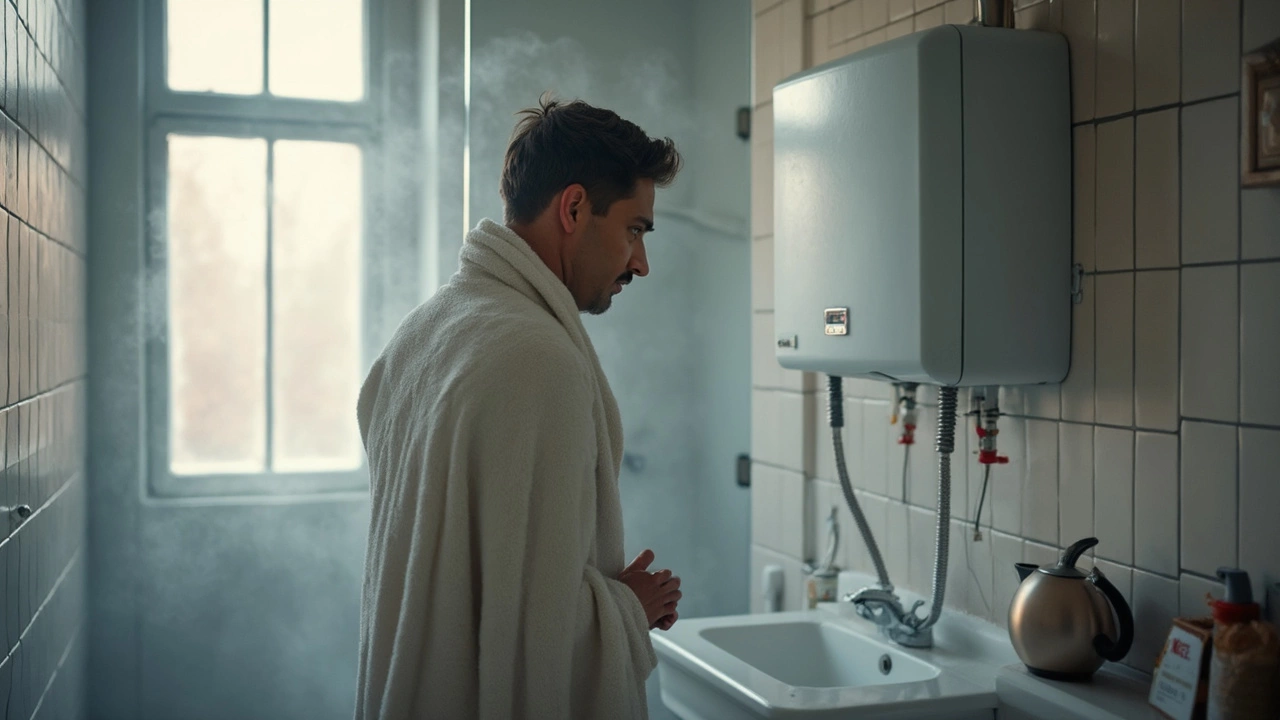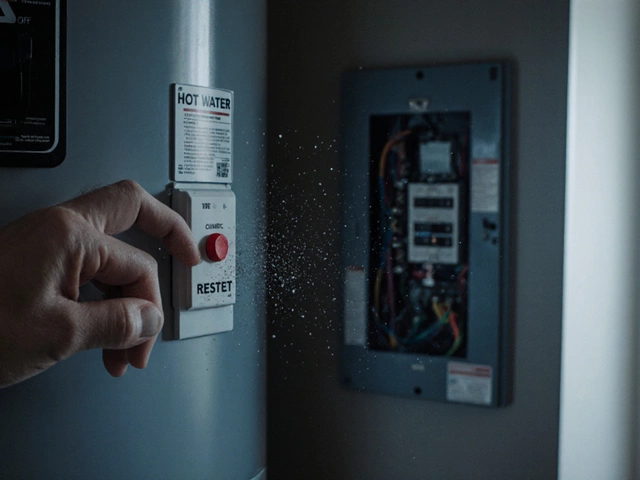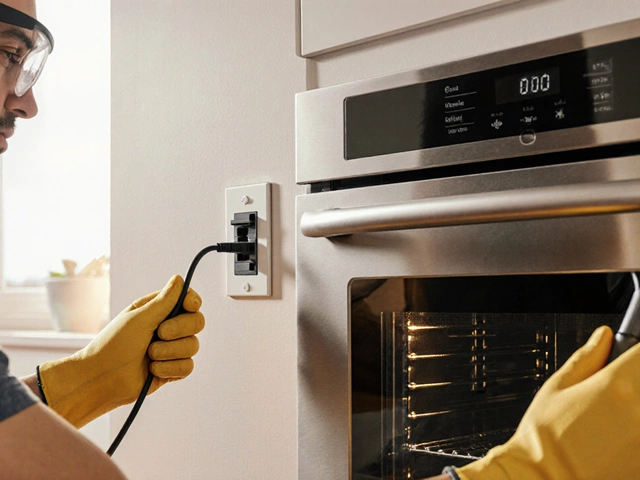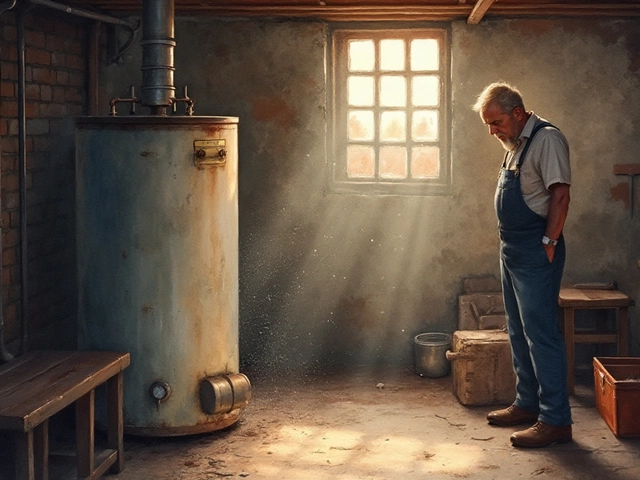If you twist the tap and all you get is cold water, it’s a rough start to your day. The good news? Most water heater issues have straightforward causes—sometimes you don’t need to be a plumber to spot them.
The most common culprits are surprisingly ordinary. Maybe there’s no power getting to the unit. Maybe your pilot light fizzled out or the circuit breaker tripped. Thermostats break, heating elements wear out, and even the good old sediment buildup inside the tank can mess with the heat. Doesn’t matter if you’ve got gas or electric—either one can go cold on you for simple reasons.
Before freaking out and calling for backup, there are a few checks you can do yourself. Look for obvious signs: is there water under your heater? See any warning lights or error codes? Sometimes, it's as quick as flipping a switch back or relighting a pilot.
Stick around, and I’ll walk you through how to sort the quick fixes from the problems that need a pro. No guessing, no confusing terms. Just the stuff you really need to know to get your water heater running hot again.
- Most Common Reasons for a Cold Water Heater
- Quick DIY Checks Before You Call for Help
- Gas vs. Electric: Different Problems, Different Fixes
- When It's Time to Replace Your Water Heater
Most Common Reasons for a Cold Water Heater
When your shower suddenly feels like an ice bath, there’s usually a practical reason. Most problems with a water heater not heating trace back to power, components, or simple aging—nothing mysterious or rare.
- No Power: Electric heaters can't heat if the breaker trips or the unit gets unplugged. Same for gas units if the gas valve is closed or pilot is out.
- Pilot Light Out (Gas Heaters): If you have a gas model, the pilot light needs to stay lit. Small drafts, worn-out thermocouples, or even dirt can make it go out.
- Faulty Thermostat: This little control tells the heater when to fire up. If it stops working, your water stays cold no matter how long you wait.
- Busted Heating Element (Electric Heaters): Electric tanks use one or two heating elements. When they burn out, you get a cold surprise.
- Sediment Build-Up: Hard water leaves gunk inside the tank. Over the years, that junk settles at the bottom and insulates the heating element, so water never gets hot.
- Leaky Tank: Big leaks aren’t just messy—they mean your heater isn’t holding water to heat up in the first place.
Authoritative advice comes from the U.S. Department of Energy:
“For conventional storage water heaters, common issues like tripped circuit breakers, faulty thermostats, or sediment accumulation are the main reasons for loss of hot water.”
If you’re curious about which culprits are the most common, here’s a quick breakdown from a 2024 survey by HomeAdvisor (based on 2,500 reports):
| Problem | % of Cases |
|---|---|
| Tripped Breaker / No Power | 34% |
| Pilot Light Out | 22% |
| Faulty Thermostat | 19% |
| Burnt Heating Element | 15% |
| Sediment Buildup | 10% |
So yeah, if your water heater turns ice cold, it’s usually one of these main issues. Most fixes aren’t rocket science, but spotting the problem early can save you a bundle.
Quick DIY Checks Before You Call for Help
Before you hunt down a plumber, you’ve got a few things you can check on your own. These steps are easy and don’t need fancy tools—just some patience and a sharp eye. If you’re lucky, your fix will be quick and cheap.
- Water heater power: For electric heaters, make sure the unit is plugged in and the breaker hasn’t flipped. Around 40% of calls for cold water issues just end up being tripped switches or breakers, according to repair techs.
- Pilot light or ignition: Gas heaters need a working pilot light. If it’s out, follow the instructions (usually stickered right on the tank) to relight it. No flame, no heat—it’s that simple.
- Thermostat setting: Sometimes, the thermostat gets bumped. Look for a dial on the tank. For most homes, 120°F is the sweet spot. Anything way lower, and you’re just asking for cold showers.
- Reset button: Most tanks have a reset (safety) button. It’s often red and sometimes hidden behind a panel. Push it, wait a few minutes, and see if that brings back your hot water.
- Check for leaks: Look under and around your tank for any puddles. If it’s leaking, shut off the water supply and power, and don’t try to use it until it’s checked by a pro.
Here’s a quick look at common problems and what percentage of calls they make up, based on home service repair data:
| Issue | How Often It’s the Problem (%) | DIY Fix? |
|---|---|---|
| Tripped Breaker/Switch | 40% | Yes |
| Pilot Light Out | 25% | Yes |
| Thermostat Issue | 20% | Usually |
| Leaking Tank | 8% | No |
| Heating Element Fault | 7% | Rarely |
If your checks haven’t done the trick and everything looks normal, that’s when it’s smart to call someone in. Messing with gas lines, internal wiring, or trying to crack open the tank goes way beyond what’s safe at home.
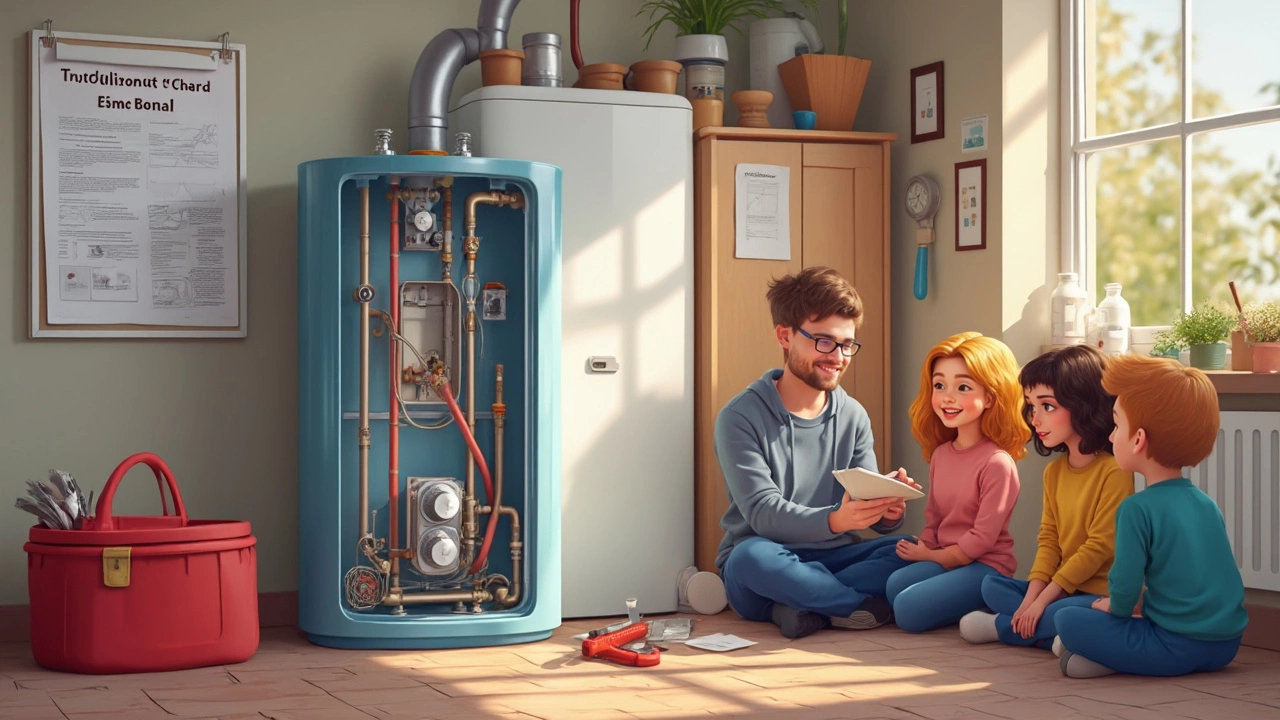
Gas vs. Electric: Different Problems, Different Fixes
You probably already know if your water heater is gas or electric; what you might not realize is that the most common fixes are totally different. Gas heaters use a burner and a pilot light, while electric ones get the job done with heating elements—think giant, hot metal rods inside the tank. Let’s break down what typically goes wrong with each, so you don’t waste time looking in the wrong spot.
Water heater troubles usually start at the power source, so always check there first. For electric models, a tripped breaker or blown fuse is a classic move—you can spot it right at your home’s panel. Gas heaters? No power means no spark to light the burner, so if the pilot won’t stay lit, look at the thermocouple (it senses the flame and shuts off gas if it’s off) or check if gas is actually getting to the unit.
Here’s a quick-hit comparison:
| Issue | Electric Heater | Gas Heater |
|---|---|---|
| No hot water at all | Broken heating element, tripped breaker, bad thermostat | Pilot light out, faulty thermocouple, no gas supply |
| Water not hot enough | One failed heating element, bad thermostat | Dirty burner, low gas pressure |
| Heater won’t start | Blown fuse, wiring issue | No gas, bad pilot assembly |
Some fixes are simple. For electric tanks:
- Flip the breaker off, then back on. Sometimes it’s just that.
- Check both thermostats (top and bottom) and reset them—there’s usually a reset button hidden behind a tiny panel.
- If you’re comfy with tools, test the heating elements with a multimeter. No reading? They’re toast.
For gas heaters:
- Look for the pilot—if it’s out, relight it following the label on your tank.
- See if the thermocouple is kinked or looks burnt. They’re cheap and easy to swap out.
- If you smell gas, stop everything and call your gas provider. Safety first.
According to a 2024 survey from a major plumbing association, about 60% of water heater service calls are solved by fixing power or pilot/power issues—just those quick basics. So always check the simple stuff before assuming it's a major breakdown. If these steps don’t sort it, you’re looking at possible part replacement or, if your heater is up there in years, maybe shopping for a new one.
When It's Time to Replace Your Water Heater
Sometimes, there’s nothing left to fix—your water heater’s just done. Even the best units have a shelf-life. On average, tank water heaters give you 8-12 years. If yours is pushing 10 and you’re only getting cold water, it’s probably time to swap it out.
Here are the telltale signs:
- Repeated need for repairs or the same issue keeps coming back.
- Heater is over a decade old (electric types sometimes last a couple years longer, but don’t bet on it).
- Rusty water from your hot tap—this probably means internal tank corrosion (game over, basically).
- Loud popping or rumbling when the unit runs, which often points to nasty sediment buildup.
- Visible leaks around the tank’s base. Once the tank starts leaking, it’s not safe or worth repairing.
There’s also the question of efficiency. Old heaters chug more energy for less hot water. Swapping to a newer model can chop your water heating bills and give more reliable hot showers.
| Water Heater Type | Average Lifespan (Years) | Signs of Failure |
|---|---|---|
| Gas Tank | 8-12 | Pilot won’t stay lit, cold water, rust, leaks |
| Electric Tank | 10-15 | No hot water, tripped breaker, leaks |
| Tankless | 15-20 | Intermittent heat, error codes, scale buildup |
Here’s a useful tip: if a repair is going to cost you more than half the price of a new water heater, it’s smarter to just go new. And don't ignore warranties—most water heaters die just outside the warranty window, like an annoying built-in timer.
If you’re shopping for a replacement, think about size, type (tank vs. tankless), and energy source. New standards brought in around 2015 made units bigger but a lot more efficient. So if you're replacing an old one, measure the space and check energy ratings before you order.
If your heater has called it quits, don’t wait too long to change it out. A leaking tank can flood your basement or attic fast. And nobody wants that mess.

